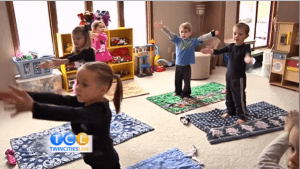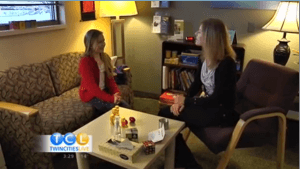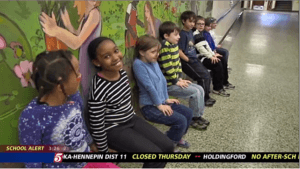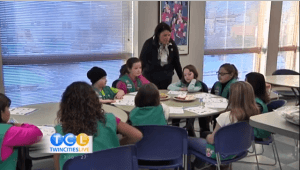We’re all enjoying our fair share of BBQs, picnics and summer outings. But are we – and our kids – aware of how to keep our food safe? Do we really know how long to grill those kabobs? Many of us could use a refresher on safe ways to handle and prepare food.
When we eat foods that have harmful bacteria or germs, we are susceptible to food poisoning. You can’t see, smell, or taste harmful bacteria that may cause illness. Most of the germs that can cause food poisoning come from animals, such as meat, eggs, milk, shellfish, raw foods and unwashed produce.
While some bacteria can be good for us, there are many things to do to prevent us from getting sick from the foods we eat. When you prepare food for yourself and your family, use these tips to help ensure that it’s safe to eat.
Wash your hands before and after handling food.
- Wash counters and food preparation areas with soap and water before cooking.
- Wash fruits and vegetables before eating.
- Only eat foods that are cooked right – if it doesn’t look done, don’t eat it.
- If a food smells or looks different than it normally would, the food might be spoiled and you shouldn’t eat or drink it.
- Keep leftovers only 3 to 4 days in the fridge and heat them up well before eating.
- Check expiration dates and use the food before it expires. Don’t eat if it is after the expiration date.
- Germs grow best at room temperature, so cover and refrigerate food right away to keep the bacteria from growing out of control.
Before you prepare your next meal, take a look at our, “Safe food is good food,” lesson to help teach your kids how to keep their food safe.
Looking for healthy recipes to share? Check out our Healthful Recipes board on Pinterest!
Whether you’re hitting the beach, playing at the park or grilling in the backyard, outdoor activities mean lots of sun. Before your little ones head outside on the next warm day, make sure they are fully protected against the sun.
As the body’s main source of Vitamin D, everybody needs some exposure to the sun. However, most people do not need a lot of sun exposure to get the vitamin D that they need. In fact, too much unprotected sun exposure can cause damage to the skin, eyes, and even cause skin cancer. Without proper sun protection, kids can end up with a painful sunburn today that may lead to some serious problems in the future.
While outside, kids should wear a sunscreen with a SPF (sun protection factor) of 30 or higher. They should also be especially careful from 10 a.m. to 4 p.m. when the sun is the strongest. It is important that sunscreen is reapplied often, especially after getting the skin wet. It may be helpful to wear long sleeves and a hat to protect the skin from overexposure.
If the skin does burn, there are some things you can do to make it feel better.
- Take a cool bath.
- Apply pure aloe vera gel to any part of the skin that is sunburned.
- Use a moisturizing cream to rehydrate the skin to treat itching.
Before your next summer outing, take some time to look at our, “Safe and Fun, In the Sun”, lesson to help the kids in your life stay safe in the sun.
Looking for a cool, refreshing snack? Blend your favorite fruits together and enjoy! This recipe calls for just four ingredients and takes just minutes. See full recipe.
Interested in getting more recipes? Sign up to receive a recipe each week via e-mail.
School’s out and it finally feels like summer. That means more activities like baseball, soccer, swimming and playing at the park to name a few – and that adds up to hungry kids! When a snack-attack hits, you want to be ready with healthy choices that give your kids the energy they need to run, swim and play on a summer day.
Kids often view snacks as a bag of chips, cookies or candy. In doing so, they are missing an opportunity to get much needed nutrients through a healthful snack choice. Snacks should be part of a healthful diet and help kids refuel between meals to satisfy hunger.
When we think of healthful snack choices we should look to the five food groups – vegetables, fruits, grains, dairy and protein. For example, string cheese (dairy) and carrot sticks (vegetable). Potato chips may start out as a healthful vegetable but after processing, it becomes high in calories, fat and sodium.
Before your next outing, take some time to look at our kid-friendly recipes on Allinahealth.org. Also check out our “Smart Snacking”, “Create Your Own Healthful Snack” and “Power Up with Snacks” lessons to help the kids in your life eat right and stay healthy.
Spring has finally sprung. You and the kids are getting outside for some fresh air and it feels great – but you’ve noticed your commitments are starting to pile up and it’s causing some anxiety. If you’re feeling stressed, it’s likely your kids are feeling it too. That’s why it’s important to recognize those feelings and take some time to find balance.
A lot of people talk about “finding balance” in life. For adults, it’s usually work-life balance. For kids, it usually means having a good mix of school, activities, time with friends and family, and time to just relax.
What sometimes gets missed in this conversation is talking about values. Values are really the foundation for how we can find balance in life. If we know what’s important to us and make decisions about how to spend our time based on that we’ll be more likely to feel at ease, successful, happy and well.
Be sure to check out our “Know What Matters to You”, It’s All in the Breathing and “Guided Imagery for Younger Children” lessons to help the kids in your life de-stress and stay balanced.
You may also be interested in learning how mindfulness can help you rediscover joyful living. According to Maureen Doran, RD, LD, Mindfulness Training facilitator, Penny George Institute for Health and Healing – Abbott Northwestern Hospital, “Many of us are in a state of ‘continuous partial attention’. In fact, we are taught to splinter our attention and focus on many things at one time.”
[KARE 11, May 7, 2014] Stress isn’t just for adults, kids feel it, too. However, there are some easy, fun ways to help kids learn to manage their stress.
Dr. Lisa Herman, a licensed psychologist with Allina Health – St. Michael Clinic, joined KARE 11 News with some great tips from the Allina Health web site, Health Powered Kids. Click here to watch the segment.
Sometimes we just need to walk (or run) it off! Can it be that a long walk or run can change your entire mood? It’s true; exercise can put you in a good mood. When you exercise, your body makes a chemical – called an endorphin – that helps you feel good. Getting enough exercise is an important part of overall health. Now that spring is here, it’s time to grab the family, go outside and get moving.
Outdoor play can help the body by:
- increasing fitness levels and building active, healthy bodies
- raising levels of Vitamin D which helps protect bone strength and may help in the prevention of chronic diseases such as heart disease and diabetes
- may help improve distance vision
- may help you breathe easier
Outdoor play can help the mind by:
- improving focus throughout the day
- helping kids score higher on tests
- improving critical thinking on projects
Outdoor play can help the spirit by:
- lowering stress levels
- protecting emotional development and lowering the risk of anxiety and depression
- enhancing social interactions and helping kids value community
- enhancing sleep time and quality
Be sure to check out our “Move It! The Importance of Daily Exercise” and “Get Out and Enjoy Nature” lessons to help the kids in your life stay fit and keep moving!
[KARE 11, April 8, 2014] We all want our kids to make healthy choices. To help them, Allina Health has created Health Powered Kids, a free and easy online educational resource to help children and teens live healthier lives.
Susan Nygaard RN, PHN, and Manager of the Health Powered Kids program joined KARE 11 News @4 with more on Health Powered Kids. Click here to watch the segment.
While spring is technically around the corner (March 20 to be exact), we’re still spending a significant amount of time indoors. In order to reduce germs and lower our chances of getting sick, it’s important to practice good hand-washing techniques.
Washing your hands is the easiest way to reduce the risk of spreading germs that cause infections. Hands get more germs on them than other parts of your body.
Everyone can benefit from learning good hand-washing techniques. You should your wash hands after:
- using the bathroom
- blowing your nose
- coughing
- sneezing
- before eating
If you can’t get to a sink, clean your hands with an alcohol-based hand sanitizer. Your friends and family will thank you!
Be sure to check out our “Wash Hands for Health!” and “Hand-Washing: A Weapon Against Germs!” lessons to help the kids in your life increase their chances of staying well!
And, until spring actually gets here, stay warm!
KSTP’s Twin Cities Live (TCL) program recently featured Health Powered Kids on the impact it’s making in the community. Four segments aired each Wednesday in January, 2014. View the segments below. Click here to watch a 30 second commercial on Health Powered Kids.
 Click here to watch the first full segment featuring a home daycare provider who uses Health Powered Kids activities.
Click here to watch the first full segment featuring a home daycare provider who uses Health Powered Kids activities.
 Click here to watch the second full segment featuring Health Powered Kids techniques and tools for managing stress and getting kids to relax and recharge!
Click here to watch the second full segment featuring Health Powered Kids techniques and tools for managing stress and getting kids to relax and recharge!
 Click here to watch the third full segment on how Power Chargers are helping kids stay engaged and attentive in the classroom at Loring Community School in Minneapolis.
Click here to watch the third full segment on how Power Chargers are helping kids stay engaged and attentive in the classroom at Loring Community School in Minneapolis.
 Click here to watch the final full segment on how the Girl Scouts are getting the benefits out of Health Powered Kids to earn an Allina Health limited edition patch.
Click here to watch the final full segment on how the Girl Scouts are getting the benefits out of Health Powered Kids to earn an Allina Health limited edition patch.

